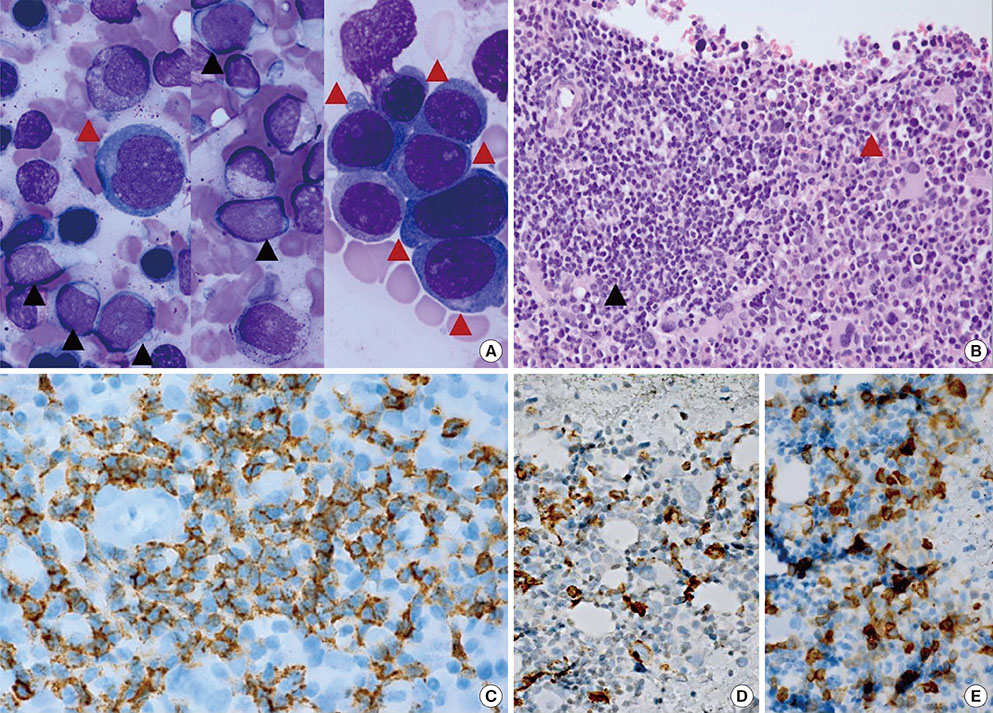Lab Med Online.
2016 Apr;6(2):98-101. 10.3343/lmo.2016.6.2.98.
A Case of Coexistence of Bone Marrow-involved Refractory Marginal Zone B-Cell Lymphoma and Therapy-related Myelodysplastic Syndrome
- Affiliations
-
- 1Department of Laboratory Medicine, University of Ulsan College of Medicine and Asan Medical Center, Seoul, Korea. cjpark@amc.seoul.kr
- 2Department of Internal Medicine, University of Ulsan College of Medicine and Asan Medical Center, Seoul, Korea.
- KMID: 2160091
- DOI: http://doi.org/10.3343/lmo.2016.6.2.98
Abstract
- Recent advances in chemotherapy have led to increased survival rates for patients with hematologic malignancies. However, standard chemotherapies, including alkylating agents for non-Hodgkin lymphoma, could induce therapy-related myeloid neoplasms (t-MNs), a group of disorders categorized by the World Health Organization in 2008. Here, we report a case of coexistence of bone marrow (BM)-involved refractory marginal zone B-cell lymphoma (MZL) and therapy-related myelodysplastic syndrome (t-MDS). Simultaneous presence of refractory lymphoma and t-MN in the BM is rare, and this is the first report in Korea. The patient received allogeneic hematopoietic stem cell transplantation (HSCT) to cure both the MZL and t-MDS. Since the HSCT, he has been stable for 21 months without any evidence of recurrence.
Keyword
MeSH Terms
Figure
Reference
-
1. Larson RA. Cytogenetics, not just previous therapy, determines the course of therapy-related myeloid neoplasms. J Clin Oncol. 2012; 30:2300–2302.
Article2. Friedberg JW. Secondary malignancies after therapy of indolent non-Hodgkin’s lymphoma. Haematologica. 2008; 93:336–338.
Article3. Shimura Y, Kuroda J, Sasaki N, Uchiyama H, Ohshiro M, Matsumura Y, et al. Reduced-intensity allogeneic stem cell transplantation for co-emergence of chemotherapy-refractory follicular lymphoma and therapy-related myelodysplastic syndrome. Case Rep Oncol. 2014; 7:188–194.
Article4. Morton LM, Dores GM, Tucker MA, Kim CJ, Onel K, Gilbert ES, et al. Evolving risk of therapy-related acute myeloid leukemia following cancer chemotherapy among adults in the United States, 1975-2008. Blood. 2013; 121:2996–3004.
Article5. Greenberg PL, Tuechler H, Schanz J, Sanz G, Garcia-Manero G, Solé F, et al. Revised international prognostic scoring system for myelodysplastic syndromes. Blood. 2012; 120:2454–2465.
Article6. Zhang L. A focused review of hematopoietic neoplasms occurring in the therapy-related setting. Int J Clin Exp Pathol. 2014; 7:3512–3523.7. Niscola P, Catalano G, Tendas A, Giovannini M, Scaramucci L, Neri B, et al. Complex and multifaceted therapy-related myeloid neoplasm following laryngeal cancer treated with Cisplatin and radiotherapy. Mediterr J Hematol Infect Dis. 2013; 5:e2013030.
Article8. Candelaria M, Dueñas-Gonzalez A. Therapy-related myelodysplastic syndrome. Expert Opin Drug Saf. 2015; 14:655–665.
Article9. Kang HJ, Kim WS, Kim SJ, Lee JJ, Yang DH, Kim JS, et al. Phase II trial of rituximab plus CVP combination chemotherapy for advanced stage marginal zone lymphoma as a first-line therapy: consortium for Improving Survival of Lymphoma (CISL) study. Ann Hematol. 2012; 91:543–551.
Article10. Park HJ, Park EH, Jung KW, Kong HJ, Won YJ, Lee JY, et al. Statistics of hematologic malignancies in Korea: incidence, prevalence and survival rates from 1999 to 2008. Korean J Hematol. 2012; 47:28–38.
Article11. Li L, Bierman P, Vose J, Loberiza F, Armitage JO, Bociek RG. High-dose therapy/autologous hematopoietic stem cell transplantation in relapsed or refractory marginal zone non-Hodgkin lymphoma. Clin Lymphoma Myeloma Leuk. 2011; 11:253–256.
Article12. Zimmerman Z, Scott BL, Gopal AK, Sandmaier BM, Maloney DG, Deeg HJ. Allogeneic hematopoietic cell transplantation in patients with myelodysplastic syndrome and concurrent lymphoid malignancy. Bone Marrow Transplant. 2012; 47:804–809.
Article
- Full Text Links
- Actions
-
Cited
- CITED
-
- Close
- Share
- Similar articles
-
- A Case of Primary Cutaneous Marginal Zone B-cell Lymphoma
- Two Cases of Primary Cutaneous Marginal Zone B-cell Lymphoma
- A Case of Monoclonal Gammopathy in Extranodal Marginal Zone B-cell Lymphoma of the Small Intestine
- A case of nodal marginal zone B-cell lymphoma of the lower eyelid
- A Case of Primary Gastric Marginal Zone B-Cell Lymphoma Presenting as Multiple Polyps


